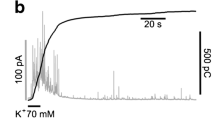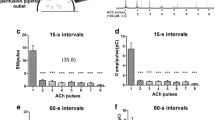Abstract
The Ca2+ current recorded by the whole-cell technique in chromaffin cells shows, before the often described rundown, a transient facilitation or runup. Initial current amplitude was 570±165 pA and then it increased by 49±23% (n=19, SD) over 2±1 min in the absence of adenosine 5′-triphosphate (ATP). In the presence of ATP, this process occurred with the same magnitude but it was slowed in a dose-dependent manner, lasting 17±2 min with 2 mM ATP (n=8). Since adenosine 5′-diphosphate (ADP) does not reproduce this ATP effect, a complex series of phosphorylations is likely to intervene and we show that, at least, a cAMP-dependent i.e., cyclic adenosine monophosphate) phosphorylation occurs. Pertussis toxin (PTX) pretreatment yielded an already maximal Ca2+ current (around 1000 pA) at the time of the patch rupture, which only slightly increased thereafter (10%, n=11). Also, guanosine 5’-diphosphate (GDP) and guanosine 5′-O-(2-thiodiphosphate) (GDP[βs]), induced a fast runup, which was absent in the presence of GTP. Furthermore, we show that facilitation does not occur in the presence of dihydrophyridine (DHP) antagonists. Globally, our data suggest that an ATP-dependent phosphorylation stabilizes the inhibitory control exerted by a PTX-sensitive G protein and, as a result, slows down the facilitation of L-type Ca2+ channels. The recruitment of L-type channels can also be facilitated by the application of a DHP agonist or a depolarizing prepulse protocol. We show that these processes are only effective over a period which parallels the runup and are not additive to it. This suggests that a single process may underlie these various types of facilitation.
Similar content being viewed by others
References
Anwyl R (1991) Modulation of vertebrate neuronal calcium channels by transmitters. Brain Res Rev 16:265–281
Armstrong D, Eckert R (1987) Voltage-activated calcium channels that must be phosphorylated to respond to membrance depolarization. Proc Nat Acad Sci USA 84:2518–2522
Artalejo CR, Ariano MA, Perlman RL, Fox AP (1990) Activation of facilitation calcium channels in chromaffin cells by D1 dopamine receptors through a cAMP/protein kinase A-dependent mechanism. Nature 348:239–242
Artalejo CR, Mogul DJ, Perlman RL, Fox AP (1991) Three types of bovine chromaffin cell Ca2+ channels. Facilitation increases the opening probability of a 27 pS channel. J Physiol (Lond) 444:213–240
Artalejo CR, Rossie S, Perlman RL, Fox AP (1992) Voltage-dependent phosphorylation may recruit Ca2+ current facilitation in chromaffin cells. Nature 358:63–66
Boland LM, Bean BP (1993) Modulation of N-type calcium channels in bullfrog sympathetic neurons by luteinizing hormone-releasing hormone: kinetics and voltage-dependence. J Neurosci 13:516–533
Bossu JL, Fagni L, Feltz A (1989) Voltage-activated calcium channels in rat Purkinje cells maintained in culture. Pflügers Arch 414:92–94
Bossu JL, De Waard M, Feltz A (1991) Two types of calcium channels are expressed in adult bovine chromaffin cells. J Physiol (Lond) 437:621–634
Bossu JL, De Waard M, Feltz A (1991) Inactivation characteristics reveal two calcium currents in adult bovine chromaffin cells. J Physiol (Lond) 437:603–620
Chang CF, Gutierrez LM, Mundina-Weilenmann C, Hosey MM (1991) Dihydropyridine-sensitive calcium channels from skeletal muscle. II Functional effects of differential phosphorylation of channel subunits. J Biol Chem 266:16395–16400
Chavis P, Nooney JM, Bockaert J, Fagni L, Feltz A, Bossu JL (1995) Facilitatory coupling between a glutamate metabotropic receptor and dihydropyridine-sensitive calcium channels in cultured cerebellar granule cells. J Neurosci 15:135–143
Chavis P, Shinozaki H, Bockaert J, Fagni L (1994) The metabotropic glutamate receptor types 2/3 inhibit L-type calcium channels via a pertussis toxin-sensitive G protein in cultured cerebellar granule cells. J Neurosci 14:7067–7076
Dolphin AC, Scott RH (1989) Interaction between calcium channels ligands and guanine nucleotides in cultured rat sensory and sympathetic neurones. J Physiol (Lond) 413:271–288
Doupnik CA, Pun RYK (1994) G-protein activation mediates prepulse facilitation of Ca2+ channel currents in bovine chromaffin cells. J Membr Biol 140:47–56
Elhamdani A, Bossu JL, Feltz A (1994) Evolution of the Ca2+ current during dialysis of isolated bovine chromaffin cells: effect of internal calcium. Cell Calcium 416:357–366
Elhamdani A, Bossu JL, Feltz A (1995). ADP exerts a protective effect against rundown of the Ca2+ current in bovine chromaffin cells. Pflügers Arch 430:401–409
Ertel EA, McHardy MS, Leibowitz MD, Cohen CJ (1994) Isolation of myocardial L-type calcium gating currents with the spider toxin ω-Aga-IIIA. J Gen Physiol 103:731–753
Fenwick EM, Marty A, Neher E (1982) Sodium and calcium channels in bovine chromaffin cells. J Physiol (Lond) 331:599–635
Gandia L, Garcia AG, Morad M (1993) ATP modulation of calcium channels in chromaffin cells. J Physiol (Lond) 470:55–72
Haws CM, Slesinger P, Lansman JB (1993) Dihydropyridine-and w-conotoxin-sensitive Ca2+ currents in cerebellar neurons: persistent block of L-type channels by a pertussis toxin-sensitive G-protein. J Neurosci 13:1148–1156
Hescheler J, Schultz G (1993) G-proteins involved in the calcium channel signalling system. Curr Opin Neurobiol 3:360–367
Hescheler J, Rosenthal W, Trautwein W, Schultz G (1987) The GTP-binding protein Go regulates neuronal calcium channels. Nature 325:445–447
Hille B (1992) G protein-coupled mechanisms and nervous signalling. Neuron 9:187–195
Hoshi T, Smith SJ (1987) Large depolarization induces long openings of voltage-dependent calcium channels in adrenal chromaffin cells. J Neurosci 7:571–580
Huang GJ, McArdle JJ (1992) Novel suppression of an L-type calcium channel in neurones of murine dorsal root ganglia by 2,3-butanedione monoxime. J Physiol (Lond) 447:257–274
Kasai H (1991) Tonic inhibition and rebound facilitation of a neuronal calcium channel by a GTP-binding protein. Proc Nat Acad Sci USA 88:8855–8859
Kostyuk PG (1984) Intracellular perfusion of nerve cells and its effects on membrance currents. Physiol Rev 64:435–454
Lopez HS, Brown AM (1991) Correlation between G protein activation and reblocking kinetics of Ca2+ channel currents in rat sensory neuron 7: 1061–1068
Lory P, Nargeot J (1992) Cyclic AMP-dependent modulation of cardiac channels expressed in Xenopus laevis oocytes. Biochem Biophys Res Commun 182:1059–1065
Mironov SL, Lux HD (1991) Calmodulin antagonists and protein phosphatase inhibitor okadaic acid fasten the “run up” of high-voltage activated calcium current in rat hippocampal neurones. Neurosci Lett 133:175–178
Netzer R, Pflimlin P, Trube G (1994) Tonic inhibition of neuronal calcium channels by G proteins removed during whole-cell patch-clamp experiments. Pflügers Arch 426:206–213
Pietrobon D, Hess P (1990) Novel mechanism of voltage-dependent gating in L-type calcium channels. Nature 346:651–655
Rane SG, Walsh MP, McDonald JR, Dunlap K (1989) Specific inhibitors of protein kinase C block transmitter-induced modulation of sensory neuron calcium current. Neuron 3:239–245
Rothe T, Bigl V, Grantyn R (1994) Potentiating and depressant effects of metabotropic glutamate receptors agonists on high voltage-activated calcium currents in cultured retinal ganglion neurons from postnatal mice. Pflügers Arch 426:161–170
Scott RH, Pearson HA, Dolphin AC (1991) Aspects of vertebrate neuronal voltage-activated calcium currents and their regulation. Prog Neurobiol 36:485–520
Slesinger PA, Lansman JB (1991) Reopening of Ca2+ channels in mouse cerebellar neurons at resting membrance potentials during recovery from inactivation. Neuron 7:755–762
Swandulla D, Carbone E, Lux HD (1991) Do calcium channel classifications account for neuronal calcium channel diversity? Trends Neurosci 14:46–51
Tiaho F, Nargeot J, Richard S (1993) Repriming of L-type calcium currents revealed during early whole-cell patch-clamp recordings in rat ventricular cells. J Physiol (Lond) 463: 367–389
Tsien RW, Bean BP, Hess P, Lansman JB, Nilius B, Nowycky M (1986) Mechanisms of calcium channel modulation by β-adrenergic agents and dihydropyridine calcium agonists. J Mol Cell Cardiol 18:691–710
Vivaudou MB, Singer JJ, Walsh JV (1991) Multiple types of Ca2+ channels in visceral smooth muscle cells. Pflügers Arch 418:144–152
Wagner JJ, Alger BE (1994) GTP modulates run-up of whole-cell Ca2+ channel current in a Ca2+-dependent manner. J Neurophysiol 71:814–816
Author information
Authors and Affiliations
Rights and permissions
About this article
Cite this article
Elhamdani, A., Bossu, J.L. & Feltz, A. ATP and G proteins affect the runup of the Ca2+ current in bovine chromaffin cells. Pflügers Arch 430, 410–419 (1995). https://doi.org/10.1007/BF00373917
Received:
Revised:
Accepted:
Issue Date:
DOI: https://doi.org/10.1007/BF00373917




